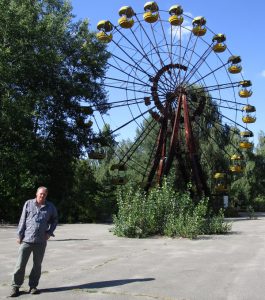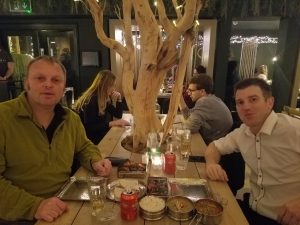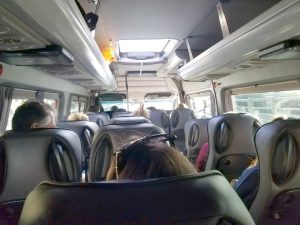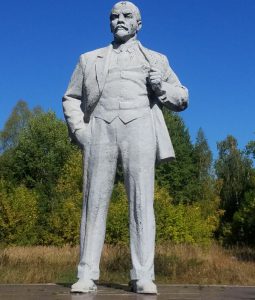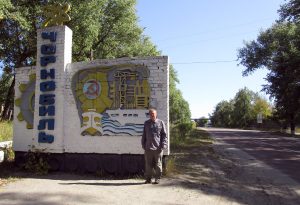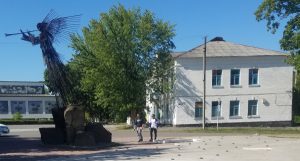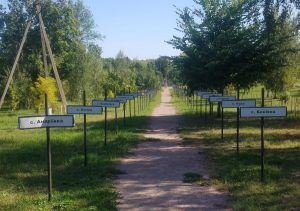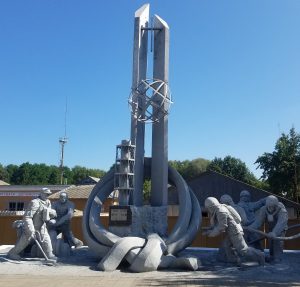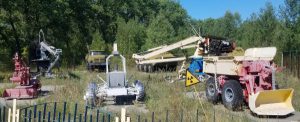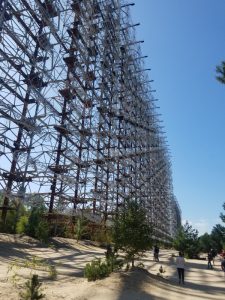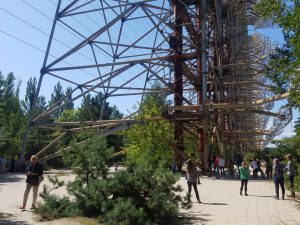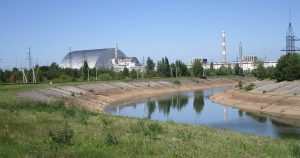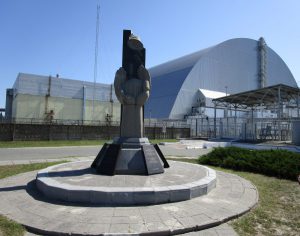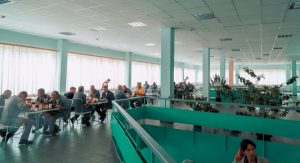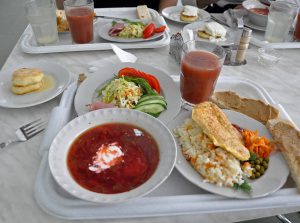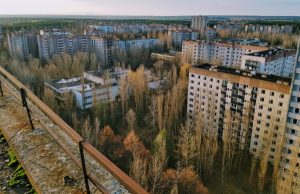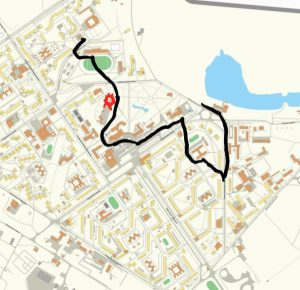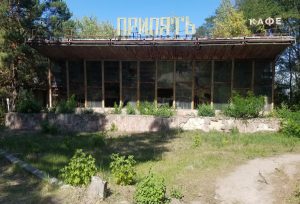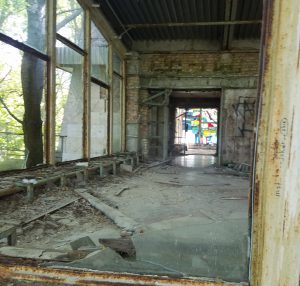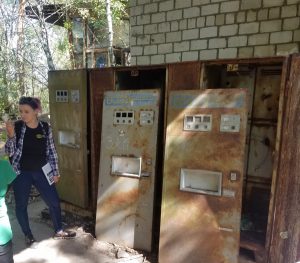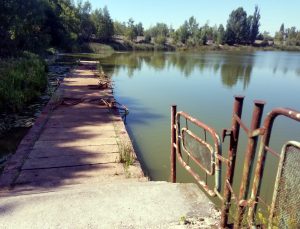I remember reading in a self help book, out of the blue, that superglue was specifically invented for emergency first aid during the Vietnam war.
Within 7 days, I’d seen reference to it in the film Dog Soldiers and the same information at the War Museum of the North in Manchester. Something similar happened with Chernobyl.
In 1986 when I was young and the world seemed too complicated, I remember seeing a reactor explosion had happened in “Russia” and a few months later, sheep in Wales and the Lake district were getting disturbing readings from the Geiger counters.
In 2013 I was playing Call of Duty 4: Modern Warfare, and found myself wandering around “Chernobyl” (actually Pripyat) in a Ghillie suit with a sniper rifle.
Realising Game of Thrones was coming to an end and the monthly yacht payments might be in jeopardy, the people at HBO/Sky decided to make a series about the incident (which not suprisingly was called Chernobyl).
I realised:
A, it was time to finally visit this place…
B, with the TV series being so popular, loads of other people would want to visit it and that would drive the price up. The time to go was now!
I got in touch with Mike Delafield (I was going to go with Nikki, but the words “It isn’t safe” kind of wrapped that up).
We arrived in Kiev and spent the day exploring.
The following day, we joined Gamma tours, piled into the minibus and headed for Chernobyl and Pripyat.
It takes 2 hours to drive there, so our first stop was at a garage to get some coffee.
To break up the journey, they showed a documentary about the massive clean up operation of the area.
Our first stop, is to see this Statue of Lenin, one of the few remaining in Ukraine.
Since declaring independence, most of these statues have been removed, yet this one remains (due to its location no doubt).
There are checkpoints at the 30 km and 10 km radius.
Me standing next to the Chernobyl town sign.
The monument to the 3rd Angel – The Wormwood star, created by Anatoly Haidamaka to commemorate all who died as a result of the Chernobyl catastrophe.
The reference is from the New Testament, Revelation 8:10-11:
“And the third angel sounded, and there fell a great star from Heaven, burning as it were a lamp, and it fell upon the third part of the rivers, and upon the fountains of waters; And the name of the star is called Wormwood: and the third part of the waters became wormwood; and many men died of the waters, because they were made bitter.”
One conspiracy theory, is reference to Wormwood in the passage. It’s been stated that Chernobyl is the Ukrainian word for Wormwood and all of this was preordained. In actual fact, Chernobyl is the word for Mugwart, which is similar but not the same as Wormwood.
When people talk about Chernobyl, they usually mean Pripyat. To explain, Chernobyl was where the nuclear reactors were located and Pripyat was a custom built town to house and entertain the workers there.
There were also a large number of villages within the 30k zone, which were dismantled and buried.
This garden has a sign for each village that no longer exists.
Memorial to “Those who saved the world”
A strange sort of thing, but it’s dedicated to the firemen and other workers who put out the fire and decontaminated the area at immense personal cost.
Another slightly odd exhibit.
Various remotely controlled robotic machines, used during clean-up
As we drive down the main road, we come a small bus stop, and a single road leading into the forest with no signs around.
We drive down several miles and then come to this. The top secret Duga radar station.
The scale of this thing, as you walk around it, is incredible. It must have taken thousands of men months to construct it.
It was reactor number 4 which exploded, but reactor 5 was half finished, with plans for a total of 8 reactors. They would provide most of the power for the whole of the Soviet Union.
The Giant radar array “DUGA-1” was an attempt at an early warning station. It never worked properly but since it required so much power, it was located near Chernobyl.
We drive towards the Industrial site of the ChNPP.
The silver dome you can see in the background, is the reactor shelter structure.
It was only when this was fully completed that modern tours as we see them today were allowed.
The whole thing was built from steel and concrete, and manoeuvred into position on specially built railway lines.
From a distance of 250m.
No pictures are allowed to be taken of the reactor, but ridiculously, you can take a picture of this monument, which originally stood in Pripyat.
It didn’t take much creativity to get the Arch into the picture.
It’s time for lunch (which was included in the price).
It had a sort of factory canteen feel you’d expect.
Not restaurant food, but filling and I ate most of mine.
I was quite thirsty and would have loved a can of coke or something. Instead, they just had this sort of juice thing.
We arrive in Pripyat for our walking tour (what would be the highlight of the trip for me).
We weren’t allowed to enter any buildings for safety reasons. I found this picture on the internet which shows the town from up high and gives you an idea of the size of it (43,000 residents lived here).
The custom-built city of Pripyat was constructed in 1970 for the sole purpose of housing the Chernobyl Nuclear Power Plant workers and their families. For 16 years, from 1970 to 1986, it was the most expensive city in the entire Soviet Union, indicating the importance of the newly constructed nuclear power plant.
Mike worked out roughly the route we took.
Prypiat ferry terminal and the riverside café
The town is named after the river it’s next too.
This cafe had amazing stained glass windows and you could get coffee and drinks while you waited for the ferry.
You can see the stained glass better from inside.
The place is very rundown but you can feel the atmosphere the moment you walk in.
Next to the building, one of the first vending machines in the Soviet Union.
You had to bring your own glass.
The ferry terminal located behind the cafe.
It was possible to get a ferry from here to Kiev to visit family or for a day out.
Overall, nothing like how I imagined life would be in the Soviet Union in 1986 !.
I’d read about dilapidated boats on the Pripyat river, but these had all gone when I was there.
There was also talk about mutated fish. I didn’t see any sign of mutation, but there were lots of fish swimming around.
